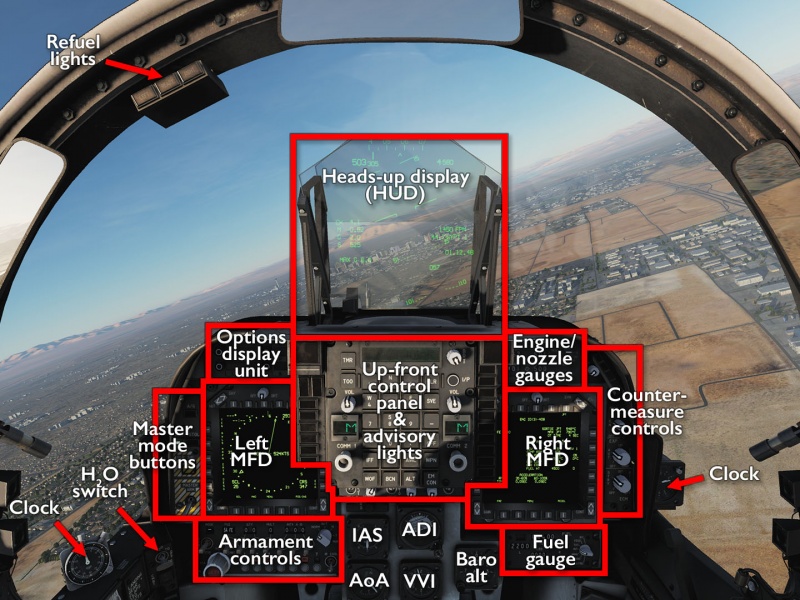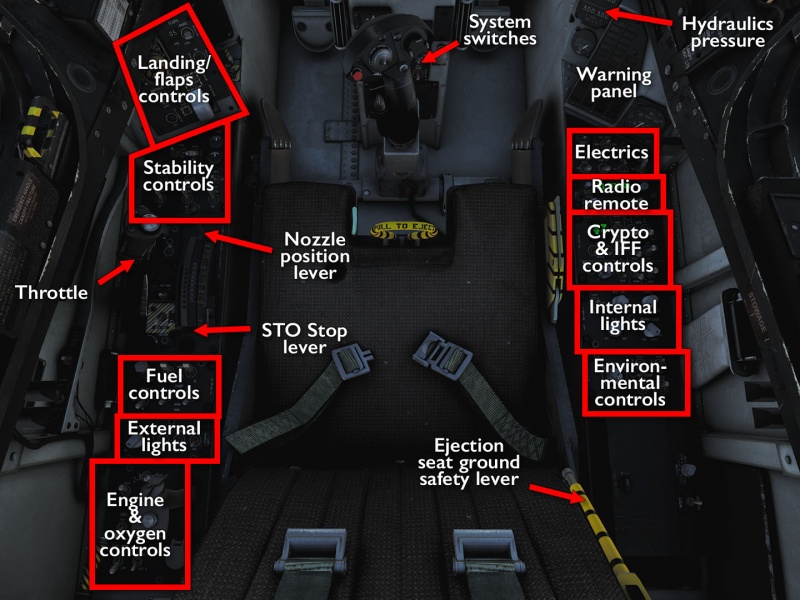AV-8B NA Harrier
| This is a beta module.
This module is still being developed and may still be missing some features and equipment options. It is playable and most of the content is there, but some final touches and fixes for minor bugs are still in the works. It is probably safe to buy unless you crave absolute fidelity and/or very few bugs. |
For those instances when going fast like a jet and also sitting still like a helicopter are just as desirable, there is the quintessential intermediate: the VTOL jump jet. Long before we got to the modern political and financial messes of Ospreys and F-35s, there was the Hawker Siddeley Harrier. First introduced in the late 1960s, it was developed into numerous different variants and generations, and licensed off to different companies to create their special version.
The AV-8B NA Harrier II available in DCS is a fairly late version, license-built by McDonnell Douglas for use by the USMC. The NA (Night Attack) variant, in particular, was designed for — shock and surprise — night-time ground attack missions, with built-in FLIR and tighter integration with NVGs and targeting pods. It uses a tilt-nozzle design to achieve V/STOL (Vertial or Short Take-Off and Landing) capabilities, primarily from aircraft carriers, but can also carry a shocking amount of precision weapons if full-length runways are available for more conventional take-offs.
The two main downsides is that with no radar and with only Sidewinders at its disposal, it is somewhat lacking in air-to-air (setting it apart from the “Plus” variant, with a radar rather than FLIR, and with the ability to carry AMRAAMs), and that it has the fuel capacity and flight range of a 1970s muscle car with a hole drilled through its petrol tank.
Features
The Harrier is a bit of a narrow-focused sub-variant of a purpose-built special version of an already fairly specialised airframe, and its feature set readily reflects this:
- Built-in FLIR and laser-spot tracking for nigh-time precision attacks.
- A LANTIRN targeting pod to further enhance its ability spot and attack things at night.
- IR- and laser-guided Maverick missiles.
- The ability to carry almost as many GBU-12 laser-guided bombs as an A-10C(!)
- A highly capable and easy-to-use automated bombing mode.
- A&hellp; quirky, let's say, but very flexible and capable sensor management system.
- A slightly less quirky, but a lot more strangely redundant, weapons management system.
- Drogue-style in-air refuelling where the probe is positioned so you can't keep your eyes on it…
The Harrier also has a side-job as something of a short-range SEAD aircraft. For this role, it comes with:
- The AGM-122 Sidearm anti-radiation missile (essentially an AIM-9 Sidewinder with its IR seeker replaced with a radar-emission seeker).
- An unusually capable jammer and counter-measure system.
And of course, it can take off and land vertically, with if you get the hang of setting the right balance between nozzle, pitch, and roll angles, and thrust settings (enough to stay up, not enough to set everything on fire) and doing it all before your fuel runs out. It has a bit of stability automation and HUD guidance to help with the process, though.
And yes, you can identify as an attack helicopter, and do hovering pop-up missile attacks from behind a hill, but chances are you will flip over and explode. And also run out of fuel.
Missing features
The Harrier is marked “Early Access” in the DCS shop, and for a good reason. It is fully capable of doing all the things you expect it to, but just like with the [[Mirage_M-2000C|M2000C], in their rush to move on to newer, more exciting products, the developers have left some details behind to (hopefully) be added later:
- It still lacks a full systems-simulating damage model, so getting hit tends to be a bit binary. You explode, catch fire then explode, or just fly a bit wonky — the detailed system deterioration you can get in, for instance, the A-10C is not there yet.
- Some weapons have been promised but are still missing, such as JDAMs, or have been pulled back with unclear descriptions of whether or when they will be back (notably many Maverick variants), and some are placeholders currently based on similar weapons, such as the Mk-20 cluster bomb.
- Some radio and navigation systems are still only shallowly simulated, with details such as INS drift and correction being a work in progress (some would argue that this is a good thing).
- The manual is still just a semi-complete “pocket guide.”
Flying the AV-8B
Jumpjet status aside, in conventional flight, the AV-8B is really easy to fly. The assist systems needed to keep it right side up during VTOL operation keep stability high even outside of that regime, and its well laid-out glass cockpit makes everything easy to keep track of.
The pilot still needs to be aware of two things, however. The first is that the Harrier's broad stubby wings means it does not like to turn — it will happily pull high AoA and lose lots of speed really fast, but actually changing direction takes a while, and side-slipping is a constant issue. You can use thrust vectoring to compensate for some of that however. The second is that those same stubby wings, and the general narrow design, means that it does not react well to asymmetric loads. Firing off a missile will imbalance the aircraft and will require a fair amount of counter-stick or trimming to stay on top of. You also want to be aware of that imbalance as you turn since, combined with the aforementioned resistance to turning, you can quite easily accidentally roll into an attitude you almost can't roll out of, where you will quickly lose speed and have the nose dip towards the ground. It rarely gets catastrophically uncontrollable, but requires some altitude to get out of, and should preferably be avoided to begin with.
Cockpit overview
Getting into the air
Getting the Harrier up and running is not a particularly complicated process. Its complexity means that it is not exactly F-5E-3 quick, but it still has fewer systems, and thus less required setup, than the A-10C. Indeed, some systems can't be fully set up while you are still on the ground because they remain in a safe mode any time you have weight on wheels.
As with pretty much all full-sim aircraft there is the standardised RWinHome “cheat” hotkey to run through the startup process, and the full process is described in the manual and Chuck's Guide linked below. The short version of it all is:
- Turn on batteries and fuel on.
- Check the engine and VTOL systems, as well as fuel status.
- Turn the APU on and let it spool up.
- Turn the engine management (DECS) on and set the parking brake.
- Push the engine start button and monitor everything to ensure nothing catches fire.
- Align the INS (a somewhat complex, but reasonably brief affair, especially if starting on a carrier).
- Turn everything else on.
- Set the STO Stop lever to a proper angle so you don't over-rotate the nozzles and do something embarrassing during take-off (70° for rolling VTO; 35° for STO).
- Set the flaps to the right mode.
- Taxi into position (shouldn't be that far if it's a vertical take-off).
- Set the nozzles and push throttle — try not to tip over until in the air.
- Pull your wheels up, slowly adjust nozzles for forward flight, and set flaps back to cruise or auto mode.
In practical terms, flipping everything on takes more steps and more time, but the part that requires attention to look smooth and stylish is all that throttle/nozzle/flaps balancing at the very end.
Shooting something
Shooting things in the Harrier is on the one hand really simple, but on the other hand, requires fairly specific procedures that are slightly different for every single weapon. This slight paradox comes down to three main quirks with how the Harrier works:
- While both MFDs are seemingly interchangeable in terms of what you can show on them, they are not functionally equivalent. Some system functions are specifically tied to either the left or the right MFD, and will simply not work if you try to use the other display.
- The armament controls are almost but not quite redundant relative to the MFD Stores page and the settings you control from there via the UFC and ODU buttons. The armament control panel is more of a legacy from earlier variants, and it provides an quick and easy way to access some settings if you want to quickly change modes on the fly rather than as part of the attack pre-planning, but it is quite easy to change things in one place and then access the other only to find that everything has been reset. The exact details of how this works are not actually all that illogical, but requires more explanation than fits here.
- The sensor management, and in particular the HOTAS sensor controls are extremely context dependent, and there is no end to how enervating they can be if you misread exactly what sensor mode you are in and accidentally make an adjustment that cancels out whatever input you were trying to adjust. Notably, the LANTIRN pod needs to be very explicitly and carefully selected, or you can quite easily flip over to a completely different sensor that puts the whole pod into standby mode where all adjustments and targeting information is lost.
As such, the whole topic of sensor management is a (long) lesson of its own, and best left for the manual, Chuck's guide, the training missions, and a myriad of online videos. Here, we will just look at two of the more simple cases.
Shooting an IR Maverick
Dropping a GBU-12
Links and files
- Chuck's AV-8B Harrier II N/A guide at Mudspike.
- DCS: AV-8B Night Attack V/STOL by RAZBAM in the DCS shop.
More information
- McDonnell Douglas AV-8B Harrier II on wikpedia.
- AV-8B Harrier on globalsecurity.org




